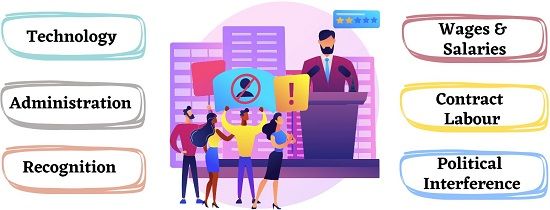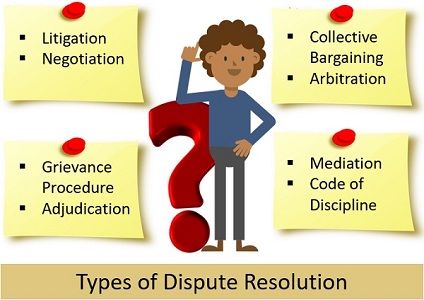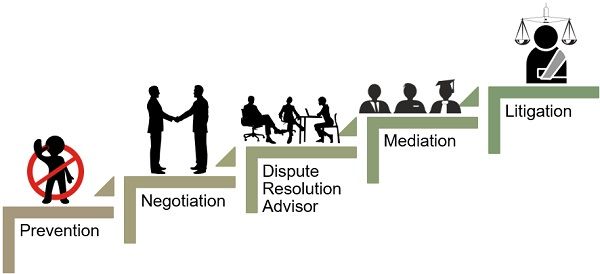Definition: Dispute Resolution refers to a process through which two parties can come together and build a consensus to end the conflict. Another term for the same is Conflict Resolution. But it is a broader term that covers severe matters.
Dispute Resolution covers all the methods of managing disputes. Also, this process requires plenty of time and energy.

Another important aspect one should keep in mind is the cost involved. It varies as per the nature of disputes and methods of their resolution.
The benefit from resolving the dispute must exceed the cost incurred in the process.
Content: Dispute Resolution
- What is a Dispute?
- Causes of Disputes
- Pre-requisites
- Types of Dispute Resolution
- Resolution Clause
- Steps Involved
- Example
- Conclusion
What is a Dispute?
A dispute is a dissimilarity in opinions between two or more people or groups. This dissimilarity can be in people’s behaviour, thoughts, interests, and goals.
It is not always unfavourable for the organization. However, it highlights that the personnel is unhealthy for the organization’s internal ecosystem.
Causes of Disputes
Disputes may arise due to the following reasons:

- Wages and Salaries: Majorly, differing opinions in industries arise due to wages or salaries-related issues. The wages offered are never enough for the workers due to inflation.
- Contract Labour: Companies often hire labours on a contractual basis. The parties may get into a conflict in some cases.
- Political Interference: Politicians instigate trade unions for their benefit. It leads to a dispute between unions and top management.
- Recognition: Disputes may arise due to the negligence of the employer. Because the employer fails to identify the bargaining intentions of the unions.
- Administration: The ill-treatment and unfair practices may also become one of the causes of conflict.
- Technology: Technical updations or installation of automated machinery result in strikes. This is because, the workers feel insecure about their jobs. So, reduced job satisfaction gives birth to severe issues and disputes.
Pre-requisites
- There must be a difference in opinion between workers or groups.
- The reason for the dispute must be work-related.
- The conflict may occur among:-
- Employer- Employer
- Employee-Employee
- Employer-Employee
- An Industrial dispute will take palace between groups. That is, the conflict between individuals and their employers doesn’t come under Industrial Disputes.
Types of Dispute Resolution
Disputes, irrespective of the root cause, have adverse impacts on the stakeholders. Therefore, the early resolution of disputes is a must.
Businesses can resolve disputes legally, but every disagreement doesn’t need legal assistance. Thus they can opt for Alternative Dispute Resolution Methods(ADR) for settlement.

Given below are various types of dispute resolution methods:
- Collective Bargaining
- Arbitration
- Mediation/Conciliation
- Code of Discipline
- Grievance Procedure
- Adjudication
- Litigation
- Negotiation
Collective Bargaining
It is the most common and participative form of resolving disputes. The representatives of both parties come forward and try to come down at the agreement state.
It secures the interest of both the employee and the employer. More precisely, it protects the rights of the union, considering the interests of the management.
Collective Bargaining results in the formation of a collective agreement. The agreement specifies a revised set of rules about:
- Wages
- Benefits
- Working hours, etc
Collective bargaining process:
- Making pre-arrangements for negotiation.
- Investigating issues to be put up while negotiating.
- Carrying out negotiation and reaching the state of agreement.
- Ratification and administration of the collective agreement.
Arbitration
Arbitration is a method of ADR for settling disputes in the industry.
Disputed parties willingly appoint an Arbitrator for the settlement. The decision of the arbitrator is legally binding for both parties.
It involves fewer formalities and procedures in comparison to Litigation.
Important Points:
- The parties accept the decision as they appoint the arbitrator themselves.
- The arbitrator provides decisions early in comparison to Litigation.
- It involves more costs compared to other types of settling the conflict.
- Careful selection of the arbitrator is a must in the process.
Mediation/Conciliation
In this, an unbiased third party assists the disputed parties in resolving conflicts.
The mediator listens to the issues of both parties and recommends suitable solutions. He acts as a catalyst between both parties.
It is less formal than arbitration and involves lower costs. The information remains confidential between all three parties.
Code of Discipline
In this, the company defines the duties and obligations of the employer and employee.
The goal behind it is to-
- Maintain discipline
- Avoid arbitration
- Improve coordination
- Aware of each other’s duties and responsibilities
Grievance Procedure
Another method of resolving disputes is by way of the grievance procedure. A pre-defined procedure is specified in the labour contracts to be followed in case of any grievance.
Disputes can be resolved with ease by following this procedure strictly.
Adjudication
It is a lawful arrangement of dispute settlement at labour courts or tribunals. When the parties fail to reach a consensus by Conciliation, they go for Adjudication.
The verdict passed by the adjudicator is legally binding. But, like Litigation, there is a delay in the final settlement due to the number of proceedings.
Litigation
This dispute resolution method involves settlement with the help of law. Generally, companies adopt this method when a large amount is involved in a dispute.
Important Points:
- A massive amount of time and money is invested in the process.
- The court is unbiased and gives a fair judgement on the dispute.
- The decision is legally binding for both parties.
- The information is not private as the proceedings take place in public.
Negotiation
In this, the disputed parties come together and try to reach a conclusion mutually. They conduct a detailed discussion aimed at finding a positive outcome.
Types of Negotiation:
- Distributive Negotiation
- Integrative Negotiation
- Multiparty Negotiation
- Text-Based Negotiation
Dispute Resolution Clause
It refers to the clause containing all the details in case of disputes and ways of its resolution.
This clause is added in the agreements/contracts to clarify the course of action. The parties must follow the instructions in the clause in case of conflict during the term.
Steps Involved in the Dispute Resolution

- Prevention: The parties must try to avoid getting into disputes. It is a negative process that requires resources, energy, funds and time.
- Negotiation: If the parties cannot prevent the dispute, they must opt for negotiation. Negotiation will help them in settling disputes at an initial level.
- Dispute Resolution Advisor: If the dispute is not resolved even after negotiation, the parties may recourse to the dispute resolution advisor.
- Mediation: The parties may take the help of a Mediator for a mutual agreement.
- Litigation: If the disputed parties still do not reach a consensus, they can go for Litigation. This may be expensive, but they will get an unbiased and binding decision.
Example
Beetal Industries is the Shoe manufacturing industry. It has 200 workers for different manufacturing processes.
In the annual meeting, the management decided to install new machines for production.
The announcement for the same led to disputes between the top brass and unions. Consequently, workers went on strike to oppose the decision.
Following are the issues that resulted in the strike:
- Layoffs of workers due to automation of processes.
- Termination in the middle of the contract.
- No job security after machinery installation.
- The company started to face heavy losses due to the strike.
- Companies manager and the union leader tried to negotiate. But, they were unable to reach any conclusion.
So, they appointed an Arbitrator to resolve this dispute. After listening to both parties and considering the evidence, he suggested:
- The workers must start production at the earliest.
- The company can install machines after the completion of the current labour contract.
- Instead of layoffs, the company must transfer the excess workers to other units.
- Also, train the existing workers to operate new machinery.
In this example, Beetal Industries adopted the Arbitration method for dispute resolution.
Conclusion
At the time of any dispute, we must try to identify the root cause of the disagreement. After that, we should adopt a necessarily suitable method to resolve the dispute.
Along with resolution, one must also consider the cost incurred in the process. It must not exceed the benefit derived post dispute resolution.
Leave a Reply